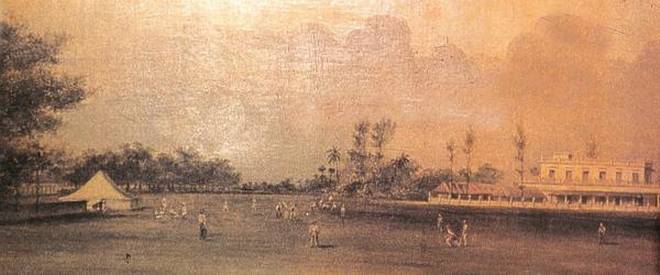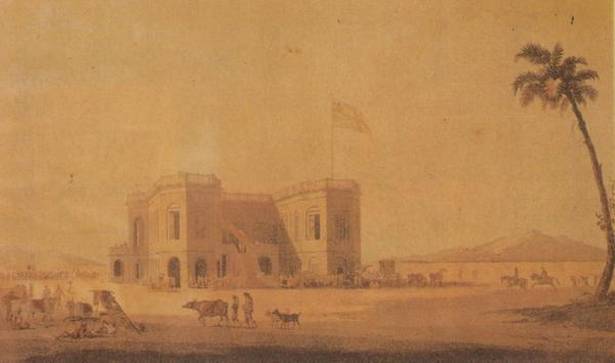Whether it was to celebrate Madras’ August birthday or not, Vikram Raghavan, a regular contributor to this column from the American capital, a Madras history buff, and a collector of Madras memorabilia, has just picked up the Thomas Daniell aquatint of Fort St George seen here. Thomas Daniell and nephew William were in India from 1785 to 1793 (Miscellany, April 21, 2008) and published in Britain between 1795 and 1808 “a monumental work”, Oriental Scenery, with 144 prints of Indian scenes. Of these, half a dozen are of Madras. A few more are of Mamallapuram, Tanjore, Madura and Rameswaram.
My favourites, one of which I would like to get a real-life glimpse of, are two of the earliest pictorial representations of sport in Madras. A print of the Assembly Rooms on the Race Course at Madras hangs in the Fort Museum. The other is of Cricket in India, an original aquatint which is with a private collector in Calcutta who once sent me a poor transparency of it. As this representation was dated 1792, it was probably done in Madras because that was when the Daniells had left Calcutta and were here. And if that was so, the match was at The Island, the only grounds for the game at the time.
In the picture, the bowler is shown bowling under-arm, the practice then; the bat is a club-like implement like a baseball bat; many of the fielders wear coloured trousers and the scorer is sitting a little wide off gully. A cow ambles about in a corner of the field in the foreground and at the left, by a few trees, is a tent, probably the pavilion. All this is really recognisable only if the picture is seen large. So take my word for it! It was sailors from East Indiamen, locally stationed British soldiers, and East India Company Writers and younger merchants who introduced the game in India. The first recorded cricket activity in the country dates to 1721, when visiting sailors played a game in Cambay, Gujarat, “to divert ourselves”, according to ship’s captain Nicholas Downton.
As for the Assembly Rooms, they were a kind of grandstand and clubhouse a little south of today’s racecourse where “entertainments” were held, a ball organised for every race day evening; the races were in the morning, then it was off to work and back again for waltzes and minuets. The first reference to organised sport in Madras, racing at St Thomas’ Mount, is in 1775.
As for Vikram’s original colour-engraved aquatint, it dates to 1797 and is titled South East View of the Fort St George, Madras. The scene was probably viewed from somewhere near Royapuram. It shows masula and other boats, four men pulling a boat through the surf, and ships well out to sea in Madras Roads. Madras Harbour was many years in the future.
*****
When the postman knocked…
Clarifying my Institute of Mental Health (IMH) story (Miscellany, June 26) is my Australian correspondent, Dr A Raman, whose hobby is Madras medical history. His research deserves a book one day. Meanwhile, a more accurate story from him than mine about what began in Purasawalkam in 1794 as ‘The Madras Madhouse’ run by Valentine Connolly. It was a leased building (at ₹825 a month) to which Surgeon Maurice Fitzgerald succeeded, holding charge until 1803. James Dalton took over, rebuilt the facility and ran it till 1815 as Dalton’s Mad Hospital. Its cases included ‘circular insanity’, later described as ‘manic depressive illness’ and today as ‘bipolar illness’.
Government involvement started in 1867 with approval for a facility to be called the Madras Lunatic Asylum (later called the Government Mental Hospital and from 1978 the IMH). The Asylum, raised in the 66.5 acres of Locock’s Gardens, Kilpauk, opened in 1871 with 150 patients and Surgeon John Murray as Superintendent. By 1915, there were 800 patients, 80 per cent of them civilians. About half the cases were classified as ‘mania’, about 20 per cent as ‘melancholia’ and about 25 per cent as ‘dementia’. ‘Criminal lunatics’ were kept segregated.
Cycling Yogis will mark Madras Week with a booklet called Cycling Trails. It includes 40 trails with details about what to see on them. Every trail in the booklet has been cycled on by the compilers over the last year. Some of the trails which caught my attention were called ‘Madras the First’, ‘Madras the Oldest’, ‘Historic Residences’, ‘Mahatma Gandhi’ and ‘Police Heritage’. For booklets, contact ramanujar4u@gmail.com, then make use of them during Madras Month.
This is not about Madras at all, but strange things happen around us all the time. And the recent strike by our Government medicos drew Don Abey’s attention to it. He refers to the Government Medical Officers’ Association in Sri Lanka calling off their agitation in mid-strike when the National Movement for Consumer Rights threatened “it would stage ceremonies in front of the homes of GMOA executive committee members to invoke God’s curses on them for holding hundreds of thousands of patients to ransom!” Powerful are the threat of death-threatening curses and pleas of consignment to Hell!
The chronicler of Madras that is Chennai tells stories of people, places, and events from the years gone by, and sometimes, from today.
source: http://www.thehindu.com / The Hindu / Home> Society> Madras Miscellany – History & Culture / by S. Muthiah / Chennai – July 10th, 2017

